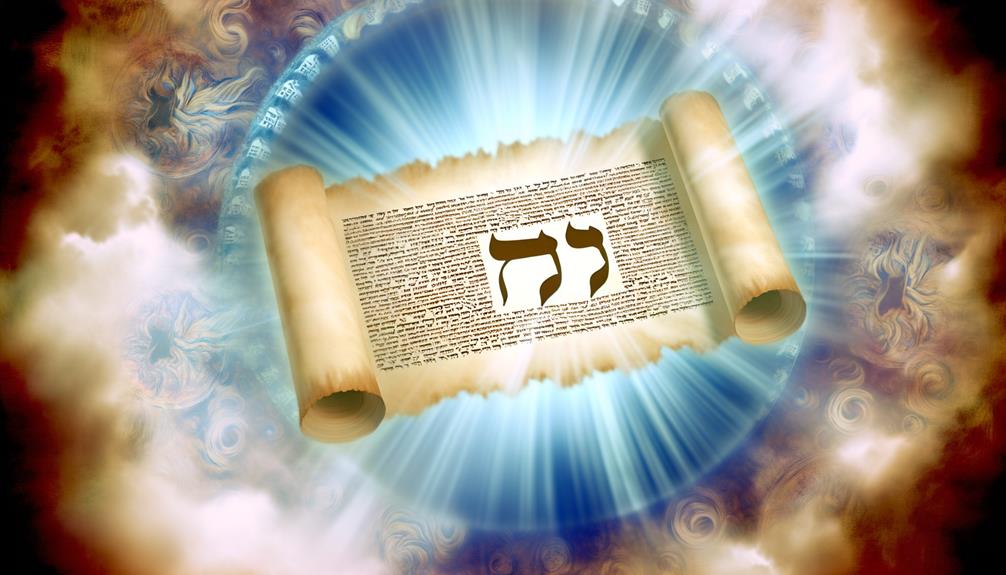Taw Meaning In The Bible: Hebrew Symbolism
In the Bible, the Hebrew letter Taw, the final character in the Hebrew alphabet, symbolizes completion, covenant, and divine truth. It marks the consummation of divine promises and underscores the fulfillment of God’s plans.
In Psalm 119, Taw signifies spiritual fulfillment and the pursuit of divine wisdom. In the book of Ezekiel, it represents divine protection and distinguishes the righteous from the judged, encapsulating themes of divine intervention, both judgment and mercy.
In theological terms, Taw embodies ultimate truth and the integrity of God’s revelations. Analyzing its role allows for a deeper understanding of its profound implications.

Taw Meaning in the Bible: Hebrew Symbolism and Spiritual Significance
| Symbol | Biblical Meaning | Scriptural Insight |
|---|---|---|
| Taw (ת) | Completion and fulfillment | Last letter of the Hebrew alphabet |
| Mark or Sign | God’s protection and ownership | Seen in Ezekiel 9:4 as a protective mark |
| Covenant Symbol | Represents God’s covenant with His people | Sign of spiritual belonging |
| Truth and Integrity | Associated with truth and faithfulness | Completes the Hebrew word for truth (emet) |
| Alpha and Omega Theme | Symbolizes the end, complementing divine order | Points to God’s eternal nature |
The Significance of Taw

The letter Taw holds profound significance in biblical texts, symbolizing themes of completion, covenant, and divine truth. As the final character in the Hebrew alphabet, Taw denotes the concept of fulfillment and ultimate resolution.
This symbolic weight is often linked with the consummation of divine promises and the sealing of covenants between God and humanity. In ancient scriptural contexts, Taw was employed to mark the completion of sacred writings, underscoring its association with divine authority and authenticity.
In addition, its usage in prophetic literature underscores the idea of a divine plan reaching its destined conclusion. Taw’s presence in biblical narratives consequently serves as a profound reminder of God’s enduring faithfulness and the eventual realization of His divine purposes.
Taw in Psalm 119

Taw, the final letter of the Hebrew alphabet, holds profound significance in Psalm 119, symbolizing completeness and culmination.
This section of the psalm encapsulates themes of spiritual fulfillment and the pursuit of divine wisdom, reflecting the broader theological implications of Taw.
Symbol of Completeness
Serving as the final letter of the Hebrew alphabet, Taw in Psalm 119 is often interpreted as a symbol of completeness and spiritual fulfillment.
This interpretation stems from its position as the concluding character, suggesting an end point or culmination.
Within the context of Psalm 119, which is an acrostic poem structured around the Hebrew alphabet, Taw’s placement underscores the idea of reaching spiritual maturity and the fulfillment of divine commandments.
The association with completeness also resonates with the thematic essence of Psalm 119, which emphasizes a holistic devotion to God’s law.
Consequently, Taw embodies not merely an alphabetic conclusion but a theological principle, encapsulating the journey towards spiritual wholeness and the consummation of one’s faithfulness to divine precepts.
Spiritual Significance Explored
In Psalm 119, the spiritual significance of Taw is intricately tied to its role in symbolizing the culmination of one’s religious journey and the ultimate fulfillment of divine commandments. This final letter of the Hebrew alphabet serves as a poignant conclusion, emphasizing the completeness of spiritual devotion.
- Symbol of Completion: Taw encapsulates the journey from aleph to taw, representing the entirety of the Hebrew alphabet and, metaphorically, the spiritual progression from beginning to end.
- Divine Fulfillment: The psalmist’s adherence to God’s laws culminates in a deeper understanding and fulfillment of divine will.
- Eternal Truth: Taw underscores the timeless nature of God’s word, urging believers to internalize and live by these eternal truths.
Thus, Taw in Psalm 119 embodies the essence of spiritual maturity.
Taw in the Book of Ezekiel

In the Book of Ezekiel, the Hebrew letter Taw holds profound symbolic significance, particularly in the context of prophetic visions.
Ezekiel 9:4-6 reveals the letter’s role as a mark of divine protection, distinguishing the righteous from those destined for judgment.
This instance exemplifies Taw’s integral place in the Hebrew alphabet as both a literal character and a bearer of theological import.
Symbolic Significance of Taw
Embedded within the prophetic visions of the Book of Ezekiel, the letter Taw emerges as a potent symbol, embodying themes of divine judgment and protection. In Ezekiel 9:4, Taw is inscribed on the foreheads of the righteous, marking them for salvation amid impending destruction. This symbolic act underscores three critical theological principles:
- Divine Discrimination: Taw signifies God’s ability to distinguish the faithful from the unfaithful.
- Judgment and Mercy: It encapsulates the dual nature of divine intervention—simultaneously judgmental and merciful.
- Covenantal Protection: Taw reflects the covenant between God and His people, promising protection to those who remain steadfast.
Thus, Taw serves as a profound emblem of divine interaction, highlighting the intricate balance between judgment and grace.
Prophetic Visions Featuring Taw
The Book of Ezekiel intricately weaves the letter Taw into its prophetic visions, particularly using it as a mark of divine selection and protection in the face of impending judgment.
In Ezekiel 9:4, the command is given to place a mark (Taw) on the foreheads of the righteous who lament the abominations committed in Jerusalem. This mark signifies divine approval and serves as a shield against the coming destruction.
The utilization of Taw here is profound; it not only designates those who are to be spared by God’s wrath but also underscores the covenantal relationship between the divine and His faithful followers.
This symbolic act emphasizes the dichotomy of judgment and mercy, encapsulating the theological depth of Ezekiel’s visions.
Taw in Hebrew Alphabet
How does the letter Taw, the final character of the Hebrew alphabet, encapsulate theological and eschatological significance within the prophetic narrative of the Book of Ezekiel?
In Ezekiel 9:4, Taw is used as a mark on the foreheads of the righteous, signifying divine protection amidst impending judgment. This usage underscores several key themes:
- Covenantal Identity: Taw symbolizes the sealing of God’s people, linking to broader covenantal promises.
- Judgment and Mercy: The dual aspect of impending judgment and selective mercy is highlighted through the marking.
- Eschatological Hope: Taw points towards an ultimate redemption and the preservation of the faithful in eschatological narratives.
In essence, Taw serves as both a literal and symbolic marker, encapsulating profound theological insights within Ezekiel’s prophecies.
Symbolism of Completion

Intriguingly, the letter Taw in the Hebrew alphabet is often regarded as a potent symbol of completion and fulfillment within biblical literature. This interpretation arises from its position as the final letter in the Hebrew alphabet, signifying the end or culmination of a sequence.
Theologically, Taw embodies the concept of divine completion, reflecting the consummation of God’s plans and purposes. For instance, in the book of Ezekiel 9:4, the mark of Taw is placed on the foreheads of the righteous, symbolizing divine protection and the fulfillment of covenantal promises.
Additionally, Taw’s association with the verb ‘to mark’ or ‘to sign’ emphasizes its role in denoting finalized actions or decrees, reinforcing its emblematic significance of ultimate completion.
Taw and Truth

Building upon its symbolic representation of completion, the letter Taw also holds a profound connection to the concept of truth within biblical exegesis. This association is not merely incidental but interwoven into the fabric of scriptural interpretation.
Taw, as the final letter of the Hebrew alphabet, underscores several key aspects of truth:
- Ultimate Reality: Taw signifies the end, symbolizing the ultimate reality or truth of God’s word.
- Divine Revelation: It emphasizes the all-encompassing nature of divine revelation, encapsulating the entirety of God’s truth.
- Faithfulness and Integrity: The letter embodies faithfulness, highlighting the unwavering integrity of God’s promises.
Thus, Taw serves as a profound symbol connecting completion and the immutable truth in biblical theology.
Taw and the Covenant

In the context of biblical theology, the letter Taw’s association with the covenant underscores its role as a symbol of divine faithfulness and the ultimate fulfillment of God’s promises to His people. Taw, as the last letter of the Hebrew alphabet, signifies completion and the enduring nature of God’s covenants throughout the scriptures.
This profound connection is evident in texts where Taw marks a sign of commitment and a spiritual seal upon the faithful. The table below illustrates key covenantal themes linked to Taw:
| Theme | Scriptural Reference | Significance |
|---|---|---|
| Divine Faithfulness | Genesis 17:7 | Everlasting covenant with Abraham |
| Fulfillment | Jeremiah 31:33 | New covenant written on hearts |
| Commitment | Ezekiel 9:4 | Marking the faithful |
This intricate symbolism highlights Taw’s integral place in the biblical narrative of covenant.
Divine Protection and Taw

The letter Taw is intricately linked to the theme of divine protection, serving as a symbolic mark of safety and preservation for those who are faithful to God’s commands. Its significance is highlighted in various biblical texts, where Taw functions as a divine seal ensuring God’s safeguarding presence.
Analyzing its scriptural applications, we find:
- Ezekiel 9:4: God commands a mark (Taw) on the foreheads of those who lament over Jerusalem’s sins, protecting them from impending judgment.
- Psalm 91: Though not explicitly mentioning Taw, the psalm reflects the protective assurance akin to Taw’s symbolism.
- Revelation 7:3: The sealing of God’s servants on their foreheads echoes the protective mark concept, reminiscent of Taw’s ancient role.
This analysis elucidates Taw’s profound role in divine protection.
Conclusion
The exploration of Taw in biblical texts reveals a rich tapestry of meanings and symbolisms, from its representation of divine protection to its connection with the covenant and truth.
Each occurrence, whether in Psalm 119 or the Book of Ezekiel, adds layers to its significance, culminating in a profound symbol of completion.
The depth of Taw’s implications invites further contemplation, leaving one to wonder what other hidden truths lie within its ancient strokes.






